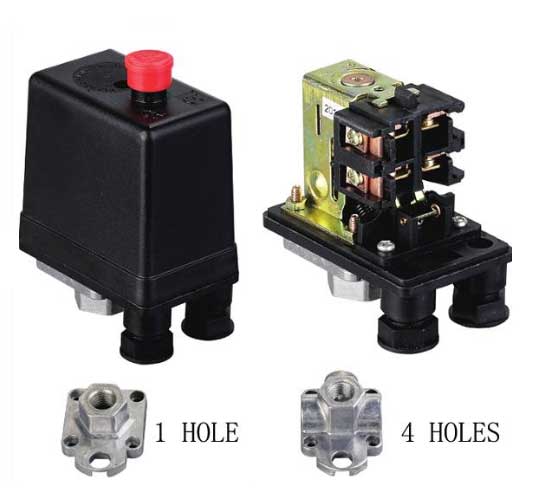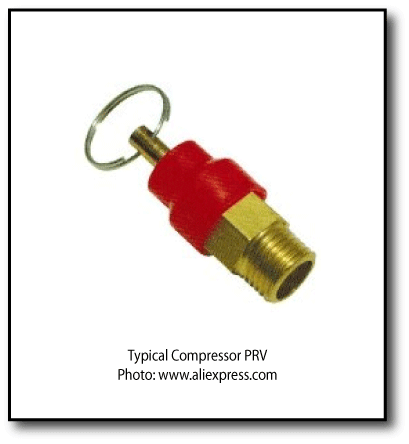This site has seen a number of folks writing in about the fact that they just added a new pressure switch, and still the air compressor will not stop. Here is one issue and some guidance on how it can be properly addressed.
Before the new pressure switch was installed, the symptoms were that the air compressor would run, tank pressure would rise, and even when the cut out tank pressure was reached, the compressor would keep running with the tank pressure continuing to rise until the PRV cracked open to vent air pressure before rising pressure became a serious issue.
Andrew wrote “I just replaced my pressure switch (120/150) due to the compressor not shutting off at 155+. Just installed exact replacement (non-adjustable Devilbiss) and the pressure keeps going up – no shut off. Any thoughts?”
Compressor Pressure Switch Accuracy / Quality
Depending on where the pressure switch was acquired, the quality of that switch will vary.

Photo: alibaba.com
I wonder how much that new pressure switch cost Andrew? The one just above is available in early 2020 from China for $1 – $2 each depending on whether you bought one or a bunch. $1 to $2 dollars! How much quality can there be in the switch for that price?
Why quality is important is that Andrew’s compressor wasn’t shutting off at the 150 PSI it was supposed to, but was still running at 155 PSI.
The fact that it was still running at 155 PSI may only be a reflection of the poor quality of that compressor pressure switch, and that particular one may have shut off at 158 PSI or 162 PSI instead. Either pressure would still be quite safe if the compressor shut off at that same pressure consistently thereafter.
Compressor Air Gauge Accuracy / Quality
The same issue can be raised as it pertains to the accuracy of the air gauge. What if, for instance, the air gauge was off by 3-5 PSI, a common occurrence for low cost pressure gauges.
The pressure switch described above may have actually tripped off at 158 PSI, but if the gauge was off, that may actually have been 153 PSI, a pressure well within the accuracy of a cheap pressure switch.
The same country that provides the pressure switch above can also provide compressor air gauges for 50 cents each and up depending on the quantity. Is it possible to deliver a precision instrument for $ .50? I doubt it!
When the air compressor will not stop!
First off, don’t panic. There is another device on the compressor that’s the backup for the pressure switch, and that is the PRV. The PRV is a pressure relief valve, and it’s cracking, or opening, pressure is set around 20-25 PSI higher than the pressure switch cut off, depending on the compressor make and model.

The compressor PRV will open and vent air before an unsafe pressure level on the compressor is reached, provided it’s in decent shape, and has been checked once in a while by pulling on the end ring and cycling it a few times. This makes sure that the PRV isn’t stuck shut. I recommend you do this at least once a year.
If the air compressor continues to run past the normal cut out, and the pressure switch has already been replaced, let the compressor until the tank pressure reaches 15 PSI over the normal cut out. The PRV should not normally release at this pressure, and it – assuming the tank is in normal shape – will be safe to do so.
If the compressor shuts off before 15 PSI over the expected pressure, vent the air below cut in, and let the compressor pump up again. If the compressor stops again at the same spot, even though it’s over the normal cut in, you should be good to go. Continue to monitor the cut out setting as the compressor is used, to ensure that the cut out pressure isn’t changing and typically it won’t.
What if the compressor pressure keeps rising?
If the tank pressure continues to rise more than 10 PSI over the normal cut out, yup, it’s time to figure out what’s going on.
I won’t write here about the workings of the pressure switch as that process is detailed on another page on this site. Simply though, if the pressure in the compressor tank continues to rise, then power MUST be getting through the pressure switch.
If the power continues to flow through the pressure switch and the tank pressure is well over the cut out pressure then simply…
- there is something blocking the tank pressure flow to the pressure switch and therefore the switch cannot react to the increasing tank pressure
- the pressure switch has failed closed – meaning power continues to flow across the points even though the tank pressure is beyond the normal cut out
- the diaphragm at the bottom of the switch that reacts to the pressure in the tank has failed and can no longer shift the switch as the pressure in the tank changes
- the pressure switch has been wired incorrectly with the wires on the wrong terminals so that the switch gets power to the motor regardless of the position of the switch points, a situation that might happen if the pressure switch points are “welded shut” as can happen if there is a short
Disassembling a pressure switch to try and fix internal parts is a frustrating challenge. Like many things, if one has no experience in doing so, the process might be defeating.
The easiest solution at this point is to acquire a new switch, replace the one on the compressor taking great care to ensure that it is off the correct pressure and voltage range of the old, and that the wiring is correct, and that may be recourse of least effort.

Had same problem on my 50ltr upright phoned manufacturer only to be told its discontinued and there’s no parts .So I’ve read the whole. Of Google on faulty compressors and came to conclusion simple thing first and ordered up a couple of pressure switches took out old one and fitted one of the new ones fired it up and whoosh safety valve blows again .Must be safety valve says me so orders new one .Week later fits new valve fires it up whoosh valve blows again severely off now but anyway I try the other new switch fires it up lo and behold it shuts off..I replaced like for like but would comment that one should fit a switch that is not so close to switching as the safety valve is to popping mine was rated at 10bar as was the pressure switch which went of at 125psi and on at 90psi.hope this rant helps you more than the supplier did for me.
This is a simple fix:
The one-way check valve (bottom of large line from compressor into tank) is stuck open or needs replacement. This is an easy fix-just remove line at top and bottom, then unscrew valve with 15/16 (?) long socket and inspect/replace